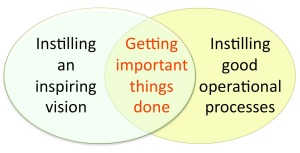Recognising this need led me to create a tailored CPD programme (resources included in this post) for middle leaders (pastoral and curriculum) specifically to strengthen their leadership skills, the impact of which has meant that Bristol Brunel is very much an academy that is ‘driven from the middle’ in a leader-leader approach rather than a leader-follower dictatorship.
High performing leadership #1
Free resource included at the end of this post.
The past year and a half has been an amazing leadership journey, both for me personally and for the Academy. Here I try to capture some of the key revelations and insights that have allowed me to develop my own leadership skills and the leadership skills of staff that I either line manage or mentor.
1. The first ‘teaching moment’ was the burning realisation of the need to explicitly support staff to develop their leadership skills, and in recognising that leading is different from managing – from running strategic meetings (as opposed to meetings constantly mired in the operational), to knowing how to grow the bright spots in a team and create vertical influence (a la Switch by Chip and Dan Heath, and Turn the Ship Around by David Marquet). The USA has long encouraged the pedagogy of leadership in every relevant institution, from companies to politics to education; Britain has been somewhat slower in this realisation; industry taking the first step, but the pedagogy of educational leadership trailing a long way behind. Why, however, do we assume that a person can go from being part of a team to running a high performing team overnight?
2, Following on from this, a second revelation in my leadership journey, through trial and error, has been recognising the need to always describe the end in mind; to describe the destination you wish to achieve for each piece of work, and understanding that a completely ‘open and unstructured‘ consultation process (i.e. starting to consult with a blank page to brainstorm) doesn’t make for a productive discussion. An example of the impact of this realisation comes from an occassion when a middle leader at the Academy asked for my advice. He had started an important piece of work (with a very diverse body of staff) with a completely open consultation process and then found himself weighed down by the effort of trying to take into account, and balance, every single viewpoint to shape a vision, hindering his progress in moving this piece of work forward. My advice to him was to stop, take a step back to look at the bigger picture and describe his own destination for this work, then to take this vision for consultation. The result was that the work recaptured its audience (the staff) through its clarity of vision and gained momentum in moving forward.
3. Thus, we come to the most fundamental revelation of my leadership learning journey: knowing when to step back from detail to look at the bigger picture; whilst still knowing how to see a vision through to become reality on the ground. Balancing the strategic vision with the operational actions.
Resources included in this post: an example of the CPD programme offered to middle leaders to develop their leadership skills and also interview skills for aspiring to senior leadership.
Free resource:
Great blogs about leadership in education:

